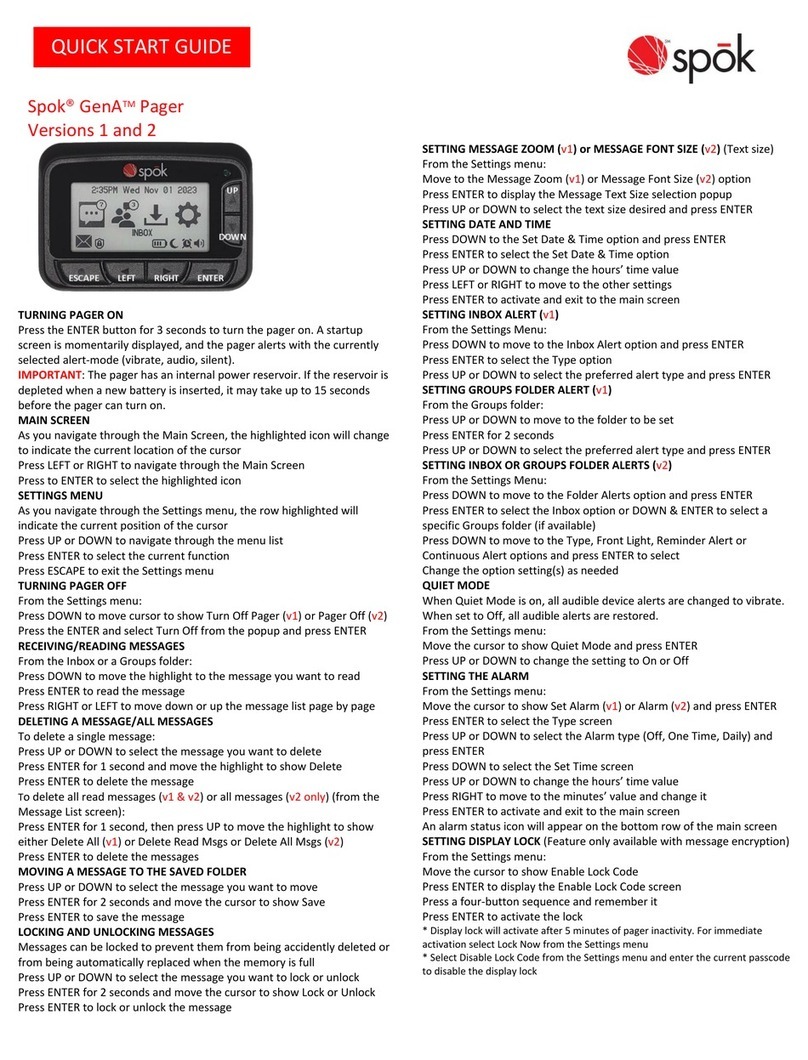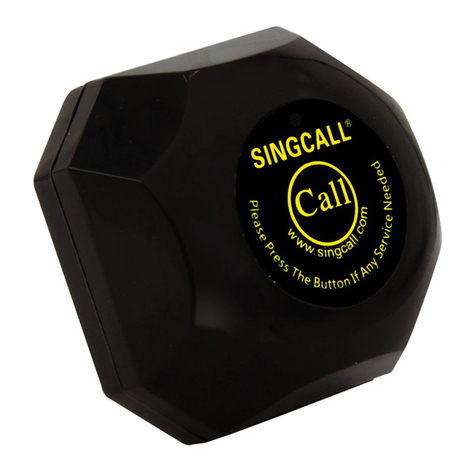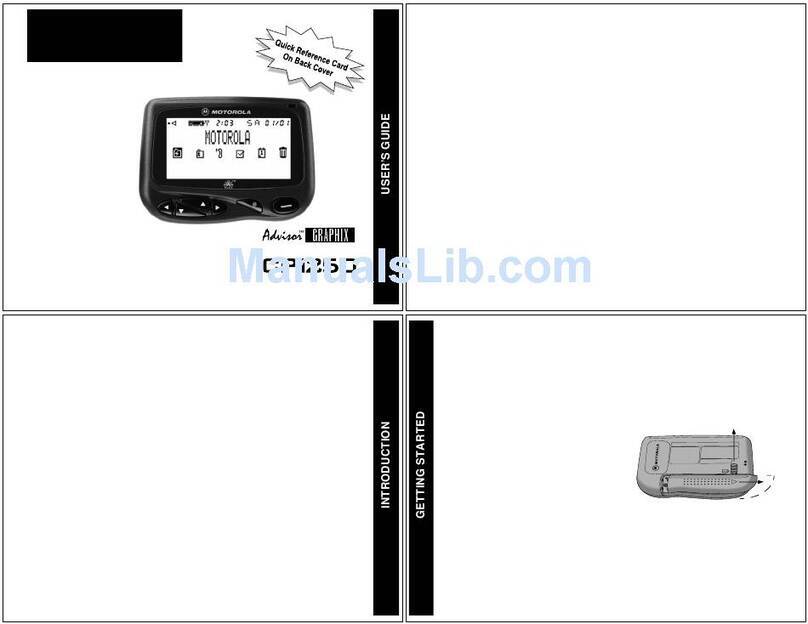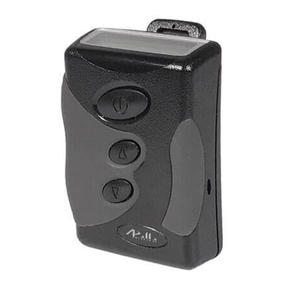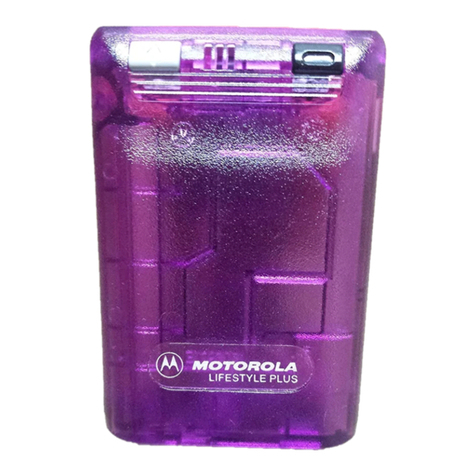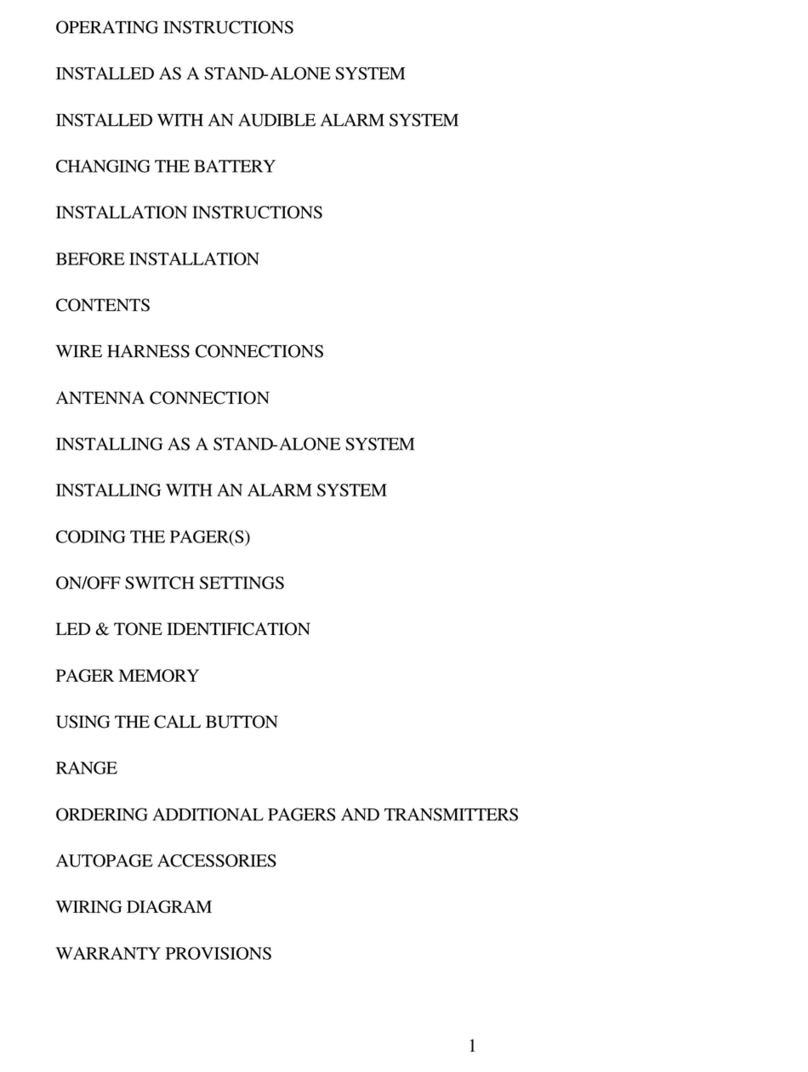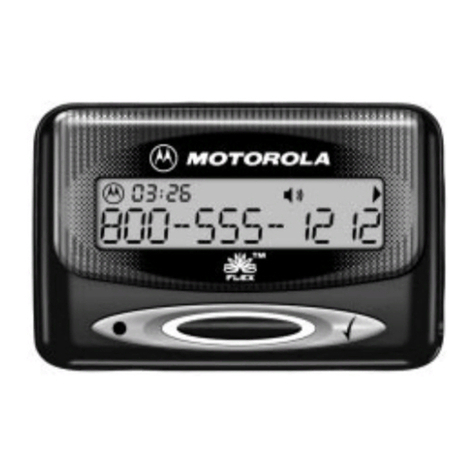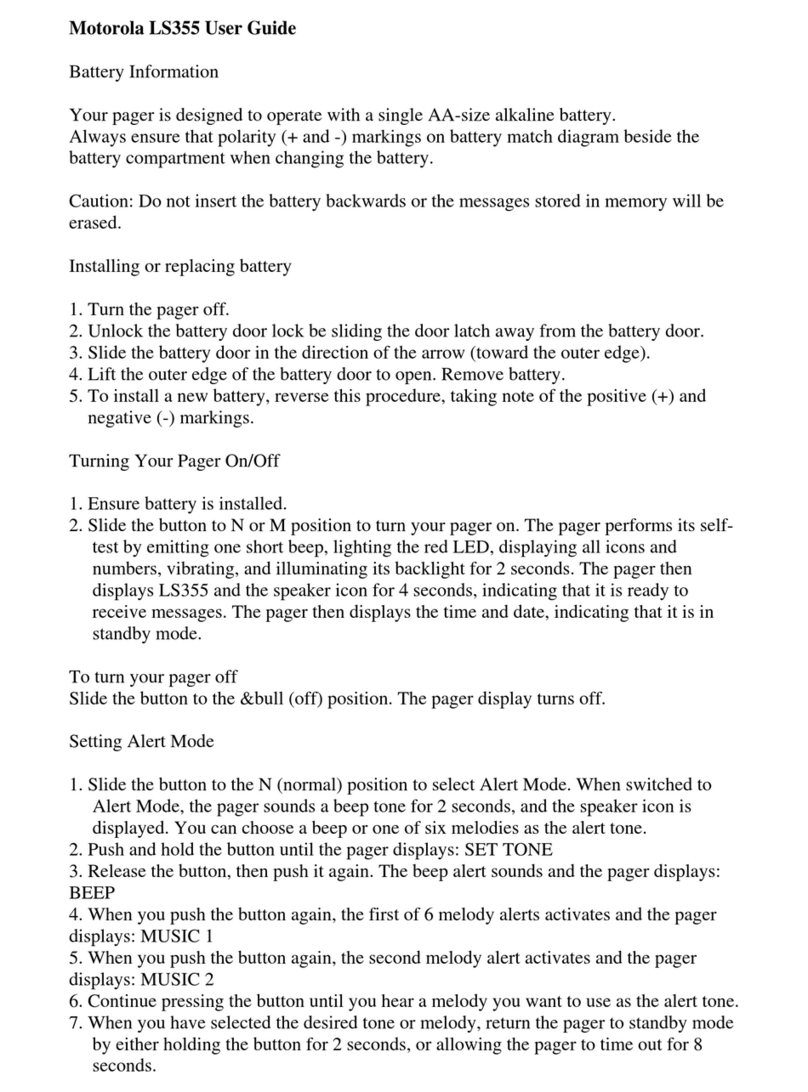Gorke Electronic OBI 3SH User manual

Frequency
433,92 MHz
Transmission
rolling code KeeLoq ® Microchip Technology)
Number of keys
4
Type of receiving module
superheterodyne
Sensitivity
-115 dBm
Power
1xbatery 9V/ 6F22 (standard) or nickel metal hydride
rechargeable NiMH 8.4V / 170mAh
Memory capacity
500 transmitters
Event log
500
Acoustic signaling
Repeating signal
the duration of signaling: 20s
every 30s until cleared
Dimension (mm)
65*100*24
Color
black
Compatibility
any GE sender (except NRP 102K), retransmitter
type RTS 100
Operating range (m):
from 150 to 800 depending on the transmiter*
Pager has acoustic signaling of low battery condition and their transmitters it conects.
Sold complete with antenna and belt clip.
TECHNICAL PARAMETERS
* Operating range
USER MANUAL
device type OBI 3SH PAGER
150 m
Remotes type PUK
300 m
The hermetic PNH 201
500 m
Panic remote PUK 303
800 m
retransmiter RTS 100, remote controls high-range RNB and stationary transmitters type NRP
The reported ranges refer to the open space (without any obstacles, when the pager and the transmitter can "see" each
other). If between pager and transmitter are obstacles, there should be a reduction in the operating range respectively
for: wood and plaster of 5-20%, 20-40% brick, reinforced concrete by 40 - 80%. With the many obstacles we advise to
use retransmitters or stronger remote controls. For metallic obstacles applying radio systems is not recommended.
1.
ON - Turn on/off the device.
•
start – hold C until the string ON appears.
•
stop – hold C until the string OFF appears.
Standby PAGER is indicated by the flashing LED.
After switching PAGER performs a power supply test, the completion of which is indicated by switching on of all
segment display. Procedures PROGRAM, EDIT and CLEAR must be performed after completion of the test power.
2.
WORKING STATE.
PAGER receive the signal from the programmed transmitter causes: switching sound signaling,
Display programmed description of the transmitter (3.4) and briefly displays the number of memory cells
PAGER under which the transmitter has been programmed. The signaling continues for 20s, then is recalled.
•
key / - Viewing alarms
•
key C - Clearing alarms
During the reset alarms first pressing C cancels the audible signal, the second pressing deletes the record on the display
and memory PAGER.
Page: 1 of 4

F
3.
PROGRAM / DELETE / EDIT SENDERS
3.1
Entry into the programming mode.
1.
LED must flash.
F + 2. Press F until the LED remains lit and on.
3.
Press
4.
The F key can be released and immediately release the key (in maximum 0,5 s).
5.
Enter password – display YES (enter the wrong password - long beep).
3.2
PROGRAMMING TRANSMITTERS TO PAGER MEMORY.
1.
Enter the programming mode(3.1).
2.
Keys -/ select a cell memory - flashing - - - - (four lines) mean free cell
3.
Press -F and let go – displayed: . (dot)
4.
Press -and let go – displayed: - (dash)
5.
Send a signal from the transmitter * – display: - - (two dashes)
6.
Resend the signal from the transmitter - display: - - - (three dashes), and then flashing: 0 0 0 0 (four zeros) which
means the correct registration of the transmitter. NO message indicates an error so you should repeat steps 3-6.
7.
Press -C –exit from programming mode.
If you need a one-time registration of more transmitters, you must repeat steps 2-6, and finally
perform point 7. Hold down -or for more than 3s, you can quickly view memory.
Warning! Each button remote control is treated as a separate transmitter which means the need for
programming into PAGER memory all keys on the remote control if they all have to be recognized by PAGER.
* Programming the remote control or a button press 201 PNH, a programming fixed transmitters trigger the transmission,eg.
press TEST.
MESSAGES ON DISPLAY:
- - - - (Four lines) memory cell is free
F U L memory cell occupied by a transmitter
N O mis-recording of the transmitter
J E S T transmitter is already programmed in the memory
A K U Lo low power state
Lb low battery transmitter
3.3
DELETE transmitters from the memory of PAGER.
F + C
1.
Enter the programming mode as 3.1.
2.
Keys - / specify a transmitter memory.
3.
Press -F and let go, dot on the display
4.
Press -C and let go, will be displayed flashing - - - - (four lines), which means
erase a transmitter from the memory.
5.
Press -C - the reset mode.
If you need to delete more transmitters, repeat point. 2-4, and finally perform point 5.
3.4.
Edit - transmitter DESCRIPTION.
1.
Enter the programming mode as in 3.1.
+ 2. Keys - / specify a transmitter memory location.
3.
Press -F and let go it displays a dot.
4.
Press -and let go – first item on display blinks.
5.
Keys - / select the desired character or number.
6.
Press -F it goes to next position on display.
7.
Press -C to exit the menu transmitter name entry.
8.
Second press C exits edit transmitter mode.
If you need to enter descriptions for more transmitters, repeat point. 2-7, and finally point 8.
Page: 2 of 4

4.
SPECIAL FEATURES.
4.1.
Password change
1. LED must flash.
F + 2. Press -F until the LED remains lit.
3.
Press -
4.
Release F key and immediately release (maximum 0.5s).
5.
Enter old password.
6.
Enter new password (any combination of the keys F C 4 characters).
4.2.
Signaling PAGER low power state.
•
BAT – must be set if PAGER is powered by a 9V battery
•
AKU – be set if PAGER is powered by a 8.4V battery / NiMH (Nickel Metal Hydride)
Changing the type of power without a change in the settings (BAT / AKU) will malfunction PAGER.
4.3.
Selecting the operating mode.
•
PNH (frequent monitoring)– if PAGER is to receive signals directly from the transmitter or retransmitter.
•
RTS (longer pause in listening) – if the system signals from all transmitters are passed by retransmitter
(type RTS 100).
RTS Mode allows extra time for battery "life", but it requires that all signals from the transmitters were
transmitted by the retransmitter. Due to the fact that PAGER in this mode goes to sleep for a longer period of time, it
cannot "hear" short signals from transmitters. The signal from the transmitter by a retransmitter is extended
accordingly.
4.4.
The choice of memory capacity.
This parameter allows you to specify the maximum number of transmitters that can be programmed into PAGER memory
from 10 to 500, in increments of 10 transmitters. The greater the number of transmitters closer to the memory limit
makes the reaction time slightly higher (1s with a limit of 500).
4.5.
Erasing memory „KASO”
This item is used to delete the total memory pager. For the functions safety has been additionally protected with a
password. Providing an incorrect password takes you "out" to normal operation without the pager erasing the memory.
Programming SPECIAL FEATURES
1. LED must flash.
+ 2. Press - until the LED remains lit.
3.
Press -
4.
Releaase the key and quickly release the key (maximum 0.5s).
5.
Enter password.
6.
Press - F please go to AKU/ BAT.
7.
Press - C and release.
8.
Whith the / keys select the PNH/ RTS mode.
9.
Press the key C and release it.
10.
The key / selects the desired maximum number of transmitters that can
be program in the memory of the pager.
11.
Press the key - C and let go – it shows „KASO” – memory erasing.
*
Pressing the key C exits the programming mode without erasing the memory of transmitters
*
Pressing the key F then re-enter the password, which will erase all transmitters from
memory. Wait until the pager reaches the position of 4499, after which it automatically exits
the reset function.
5.
EVENT LOG.
If PAGER receives and decodes the signals from the transmitters, and they will not be deleted, it will be automatically
preserved in the memory of events. Then, every 30s PAGER gives out two short beeps that will remind of the signals
stored in the memory of events.
You can use at any time the specific keys / to view the event log, also you can press the key C
to delete
individual events (remembering that the first resets audible signal, then the information from the display).
After a power cut memory of the event is canceled. The event memory can be read up to 500 events back.
Page: 3 of 4

6.
POWER.
PAGER can be powered from a 9V alkaline battery type 6F22 or nickel-metal hydride battery type NiMH 8.4V min. 170
mAh, the PAGER ca not be used to charge the battery.
PAGER operating time in standby mode (hours):
PNH mode
RTS mode
Rechargeable battery
~ 80
~ 160
Battery
~ 260
~ 500
The measurement was performed for battery VARTA INDUSTRIAL 9V NiMH battery 8.4 V / 170 mAh under "radio
silence”.
PAGER working time is reduced significantly and is dependent on the amount of the received signals.
Low battery or battery is signaled by a short beep generated every 1 minute of a 20 minutes cycle signal / 10-minute
break. 10 seconds before the complete exclusion PAGER is generated continuously beeps and displays a message AKU
Lo.
7.
DEFAULTS.
Indication of low power
BAT
Operating mode
PNH
Password
4 x keys
Memory capacity
100 transmitters
8.
NOTES.
Occasionally it can happen that the PAGER beeps, but nothing appears on the display. If that happens, wait a few /
several seconds until the display shows information from the received transmitter. This happens when at the same time
the signals are coming from more transmitters at a time.
Analogously to the previous situation, it may happen that PAGER received signal from the transmitter and displays about
it and beeps, but by pressing the C button nothing happens, in such a situation also, wait a few / several seconds
until the information is erased. This happens when at the moment of alarm reset, a new information is coming from
other transmitters.
When PAGER over analyze newly received signals, it will automatically execute the clear command of the "old" alarm.
PAGER remembers previously pressed reset button. PAGER will work for as long as possible on battery - it was designed
primarily to work with press airtight PNH 201. If the PAGER transmitters are to cooperate whit NRP stationary or
portable remote controls it must be ensured that the transmission of the signal from such transmitter lasts a minimum
of 0.5s. Shorter then 0.5s may result in erroneous decoding by PAGER, which ultimately causes no reaction to the
signal.
Page: 4 of 4
Table of contents
